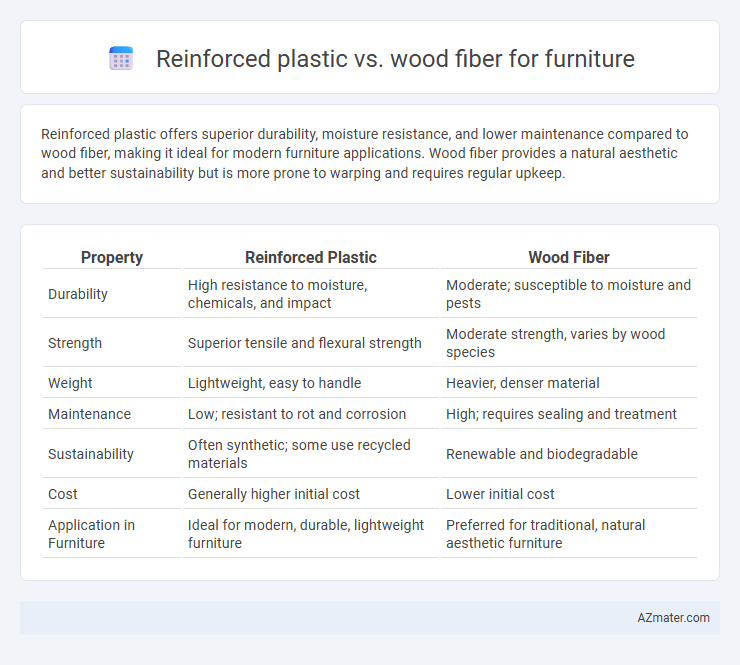Reinforced plastic offers superior durability, moisture resistance, and lower maintenance compared to wood fiber, making it ideal for modern furniture applications. Wood fiber provides a natural aesthetic and better sustainability but is more prone to warping and requires regular upkeep.
Table of Comparison
| Property | Reinforced Plastic | Wood Fiber |
|---|---|---|
| Durability | High resistance to moisture, chemicals, and impact | Moderate; susceptible to moisture and pests |
| Strength | Superior tensile and flexural strength | Moderate strength, varies by wood species |
| Weight | Lightweight, easy to handle | Heavier, denser material |
| Maintenance | Low; resistant to rot and corrosion | High; requires sealing and treatment |
| Sustainability | Often synthetic; some use recycled materials | Renewable and biodegradable |
| Cost | Generally higher initial cost | Lower initial cost |
| Application in Furniture | Ideal for modern, durable, lightweight furniture | Preferred for traditional, natural aesthetic furniture |
Introduction to Furniture Materials: Reinforced Plastic vs Wood Fiber
Reinforced plastic offers high durability, resistance to moisture, and low maintenance, making it ideal for outdoor and heavy-use furniture applications. Wood fiber, derived from natural wood byproducts, provides an eco-friendly option with good strength and aesthetic appeal, often used in indoor furniture and sustainable design. Choosing between reinforced plastic and wood fiber depends on factors such as environmental impact, required strength, and intended furniture use.
Material Composition and Properties
Reinforced plastic combines polymer resins with glass or carbon fibers, offering high strength-to-weight ratios, exceptional durability, and resistance to moisture and chemicals compared to wood fiber. Wood fiber, derived from natural cellulose, provides biodegradability, breathability, and aesthetic warmth but is more susceptible to moisture, warping, and decay. Material composition directly influences furniture performance: reinforced plastic excels in longevity and structural integrity, while wood fiber emphasizes eco-friendliness and natural texture.
Strength and Durability Comparison
Reinforced plastic offers superior strength with high resistance to impact, moisture, and environmental factors compared to wood fiber, making it ideal for long-lasting furniture in both indoor and outdoor settings. Wood fiber, while providing natural aesthetics and moderate strength, is prone to warping, rot, and insect damage, reducing its durability over time, especially in humid conditions. Reinforced plastic combines polymers with fibrous materials, enhancing structural integrity and maintaining stability under heavy loads and frequent use, outperforming conventional wood fiber composites in durability.
Aesthetic Versatility and Design Options
Reinforced plastic offers extensive aesthetic versatility with its ability to be molded into complex shapes and finished in a wide range of colors and textures, enabling innovative and modern furniture designs. Wood fiber provides natural warmth and unique grain patterns that enhance organic and rustic styles, appealing to consumers seeking eco-friendly and tactile materials. The choice between reinforced plastic and wood fiber significantly influences the design options, balancing synthetic adaptability with natural beauty in furniture craftsmanship.
Environmental Impact and Sustainability
Reinforced plastic furniture offers durability and resistance to weathering but often relies on non-renewable petrochemical resources, contributing to environmental pollution and challenges in recyclability. Wood fiber furniture, derived from renewable and biodegradable materials, supports carbon sequestration and promotes sustainable forestry practices, though it may require treatments that affect its ecological footprint. Selecting wood fiber furniture generally aligns better with sustainability goals due to its renewable origins and lower lifecycle emissions compared to reinforced plastic alternatives.
Cost Analysis: Production and Long-Term Value
Reinforced plastic furniture typically involves higher initial production costs due to expensive raw materials and energy-intensive manufacturing processes, but it offers superior durability and low maintenance, resulting in lower long-term expenses. Wood fiber furniture generally requires less upfront investment and provides natural aesthetics, though it may incur additional costs over time due to susceptibility to environmental damage and the need for periodic treatments. Evaluating both materials' cost-effectiveness involves balancing initial expenditure against lifespan, maintenance, and replacement frequency to determine overall value.
Maintenance Requirements and Longevity
Reinforced plastic furniture offers superior resistance to moisture, pests, and environmental wear, requiring minimal maintenance compared to wood fiber, which is prone to absorption, rot, and insect damage needing regular sealing or treatment. The durability of reinforced plastic extends furniture lifespan significantly, often lasting decades without structural degradation. In contrast, wood fiber furniture demands consistent upkeep to prevent warping and decay, typically resulting in a shorter service life under similar conditions.
Weight and Handling Considerations
Reinforced plastic furniture is significantly lighter than wood fiber counterparts, making it easier to maneuver and transport in various settings. The composite nature of reinforced plastics offers superior strength-to-weight ratios, enhancing durability without adding bulk. In contrast, wood fiber furniture typically weighs more, which can hinder handling but provides a sturdier, more traditional feel preferred for stationary pieces.
Indoor vs Outdoor Furniture Performance
Reinforced plastic offers superior durability and resistance to moisture, making it ideal for outdoor furniture exposed to varying weather conditions, while wood fiber excels in indoor settings due to its natural breathability and aesthetic appeal. Wood fiber furniture typically requires more maintenance and is susceptible to warping and decay when exposed to outdoor elements. Reinforced plastic's low porosity and UV resistance ensure longevity and minimal upkeep in outdoor environments, contrasting with the warmth and sustainability of wood fiber favored indoors.
Future Trends in Furniture Material Innovation
Reinforced plastic offers superior durability, moisture resistance, and design flexibility compared to wood fiber, making it a leading choice in futuristic furniture innovation. Emerging technologies emphasize eco-friendly reinforced composites using recycled plastics and bio-based fibers, reducing environmental impact while enhancing performance. Trends indicate a shift towards hybrid materials that combine the aesthetic warmth of wood fiber with the strength and longevity of reinforced plastics for sustainable, high-performance furniture solutions.

Infographic: Reinforced plastic vs Wood fiber for Furniture
 azmater.com
azmater.com